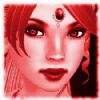From the time i knew that Devdutt Pattnaik was the chief consultant for this mahabharat series i was thinking if the discrepencies in storytelling is his doing or not. Whether the story being told was from his book or not. hence curious i bought his book Jaya: An Illustrated Retelling. The very first page was shocking and humbling to me. If what he has written is true then we dont know mahabharata at all and i cant find a reason for it to be false also. I wish to share it here with you:
"Vyasa classified the hymns and created four collections"Rig, Yajur, Sama and Atharva. On completing this monumental task, Vyasa had this inexplicable urge to write a story, one that would convey the most abstract of Vedic truths to the simplest of men in the farthest corners of the world in the most concrete of forms. The gods liked the idea and sent the elephant-headed Ganesha to serve as his scribe.
Ganesha said, You must narrate without a pause.' This would ensure that what Vyasa dictated was not adulterated by human prejudice.
I will,' said Vyasa, provided you write nothing unless it makes sense to you.' This ensured that all that was written appealed to the divine.
The characters of Vyasa's tale were people he knew. The villains, the Kauravas, were in fact his own grandchildren.
Vyasa called his tale Jaya, meaning the tale of a victory'. It had sixty portions. Of these, only one part reached humans through Vyasa's student, Vaisampayana. Thus no one really knows everything that Vyasa narrated and Ganesha wrote down.
Vaisampayana narrated Vyasa's tale at the yagna of Janamejaya, the great grandson of the Pandava Arjuna. This was overheard by a Sauti or bard called Romaharshana, who passed it on to his son Ugrashrava, who narrated it to Shonak and the other sages of the Naimisha forest.
Vyasa also narrated the story to his son, the parrot-headed Suka, who narrated it to Parikshit, Janamejaya's father, comforting him with its wisdom as he lay dying.
Jaimini, another of Vyasa's students, also heard his teacher's tale. But he was confused. Since Vyasa was not around to clarify his doubts, Jaimini decided to approach Markandeya, a Rishi blessed with long life, who had witnessed the events that had inspired Vyasa's tale. Unfortunately, by the time Jaimini found Markandeya, the sage had renounced speech as part of his decision to renounce the world. Markandeya's pupils then directed Jaimini to four birds who had witnessed the war at Kuru-kshetra. The mother of these birds was flying over the battlefield when she was struck by an arrow that ripped open her womb. Four eggs fell out and fell to the ground. The ground was bloodsoaked, hence soft. The eggs did not break. The bell of a war-elephant fell on top of them and protected them through the battle. When they were discovered after the war, the Rishis realized the birds had heard much during the war and knew more than most humans. Their perspective and insights would be unique. So they were given the gift of human speech. Thus blessed, these birds were able to talk and clarify Jaimini's doubts. They also told Jaimini many stories that no one else knew.
As Vyasa's tale moved from one storyteller to another, new tales were added, tales of ancestors and descendants, of teachers and students, of friends and foes. The story grew from a tiny sapling into a vast tree with many branches. At first it was about an idea. Then the idea changed and it came to be known as Vijaya. Before long it became not about any idea but about people. It was retitled Bharata, the story of the Bharata clan and the land they ruled.
The expansion continued. Detailed conversations on genealogy, history, geography, astrology, politics, economics, philosophy and metaphysics were included. The Bharata came to have eighteen chapters and over a hundred thousand verses. Even the story of Krishna's early years, the Harivamsa, was added as an appendix. That is how the Bharata came to be the Mahabharata, the great' epic of the Indian people."

























comment:
p_commentcount